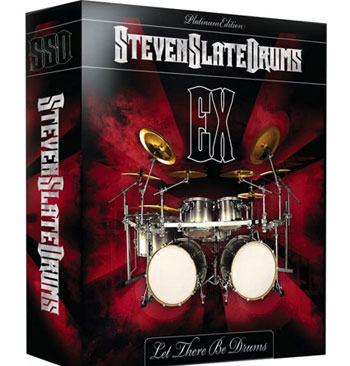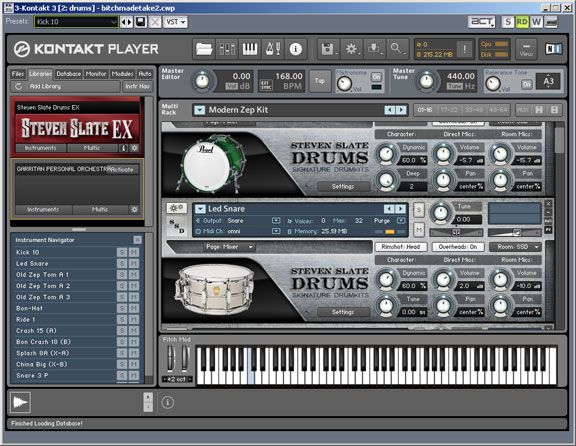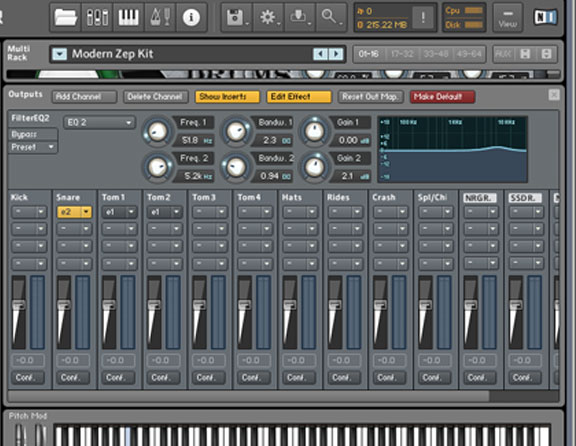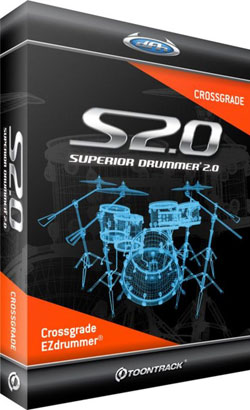
When you hear the name Toontrack you might think of a low-budget, possibly pornographic Walt Disney rip-off animation company. But they are in fact a bunch of Scandinavian wunderkinds who produce massive VST virtual drum kits. They might also do porn on the side, but I think that’s pretty standard for Scandinavians (they love their scat vids!).
The Dirty Marmaduke Flute Squad found out about Toontrack years ago, during the mixing of Die Humpin! We were pretty committed to using the built-in sounds from our Roland TD-6v drum module, which at the time (when properly tweaked) sounded better than almost anything else out there. But then Toontrack came out with EZDrummer, and totally blew away the drum sample community (yes, there actually are people who obsess over drum samples). So we quickly bought EZDrummer and remixed many of the songs on Die Humpin! with their sample sets, with varying results.
Essentially Toontrack had done something revolutionary with EZDrummer by creating an ultra-realistic VST sample set with a minimal RAM footprint and an interface that was simple and easy to use. Plus, at the time it seemed cheap: around $150 for the basic EZDrummer program, which included their Rock kit, and then another $100 for each additional expansion kit, which now includes Nashville, Vintage, Electronic, and a host of others that can match just about any style you’re up for.
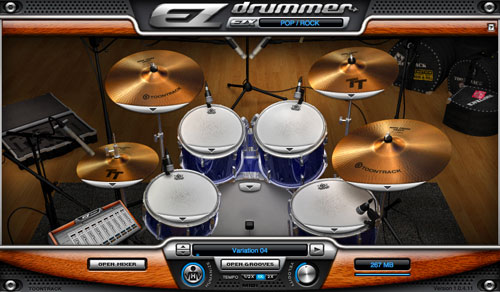
However, a few years later Toontrack one-upped themselves with a more advanced version of EZDrummer: Superior Drummer. The interface is a lot more complicated, but with that comes much greater control over the processing of each piece of the drum kit, as well as the ability to mix and match individual pieces from the various EZDrummer expansion kits. So, say for example you love the kick in the Vintage kit but the snare isn’t punchy enough. With EZDrummer you’d have to load up in an additional instance of another expansion pack just for the snare (i.e., another VSTi on a different track, with the snare midi split out and sent to the new track). But with Superior Drummer you can just load up a snare from the Nashville pack as an X-drum, and then load in a handclap from the Electronic pack, a single dry tom from the Twisted Kit, etc, all within the same VSTi.
Furthermore, you can now blend multiple kit pieces, so if you like the attack from a Drumkit From Hell metal kick, you can layer that over the warm low-end of a kick from the Funk pack. Another critical addition is the inclusion of built-in effects such as compression and EQ, so you’re no longer stuck with the pre-processed sounds of EZDrummer, but can shape the sounds to fit your song, all within the confines of the Superior Drummer interface.
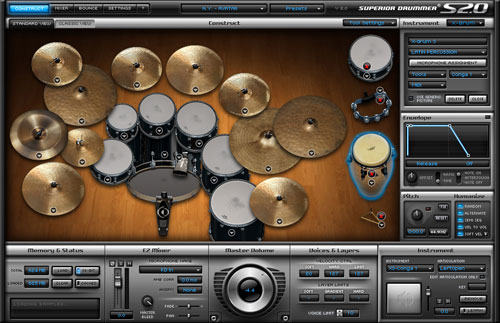
Unfortunately, Superior Drummer isn’t as cheap as EZDrummer, so it’s going to cut some of you home studio folks out of the equation. We’re looking at $250 for the main program (although there are sales that pop up occasionally) and another $200 for each of the Superior-specific expansion packs. My advice is to skip EZDrummer altogether, spend the extra cash for Superior Drummer (which gets you two pretty great and versatile kits) and then wait for sales on the EZDrummer expansion packs, which can then be loaded into Superior Drummer for a wide range of sounds.
So, how does it sound, you ask? Well, it sounds great, but compared to Steven Slate Drums EX, you definitely need to put more effort into getting the kits to fit into a cluttered mix. EZDrummer is already pre-processed with compression and EQ like SSD, but for whatever reason the samples don’t have the punch of SSD. As a result, you need to add a lot more additional effects to the instruments to get them to work with your mix, which means you need to split out each channel to individual tracks in your multitrack program and use the included or 3rd party plugins to sculpt your sounds.
And what you’re getting with Superior Drummer are unprocessed drum sounds, just like you’d have if you recorded a real drum kit. It’s up to you to flex your mixing skills by using compression and EQ (which are included in the program), and to blend in the overheads and room mics to the appropriate levels. They do offer presets for various styles, but not many (although preset packs are apparently in the works, with the Allen Morgan presets being the first release).
That said, these kits fit places that the Steven Slate kits would stand out, such as in acoustic-based music, jazz, hip-hop, or basically any other style of music that doesn’t involve a lot of distorted guitars. For example, here are two clips from songs off our new album Boneslinky where the SSD kits just sounded completely out of place.
First is a clip from a new song from Boneslinky! called “You’re Special“.
We’re using a brush kit here, something not available with SSD, and one of Toontrack’s strong points. Obviously a regular rock or pop kit would simply not work with this song, but the Toontrack kit fits in just fine.
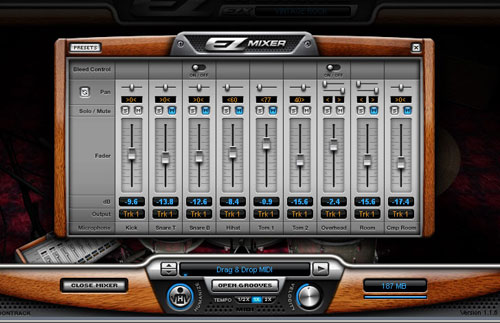 Notice we’re only using the overhead, kick, and room mics here, just like you might when mixing a real kit for this sort of song. Also notice that no internal processing is available on a per-channel basis in EZDrummer.Next up is another clip from Boneslinky! from the song “Country Robots”.
Notice we’re only using the overhead, kick, and room mics here, just like you might when mixing a real kit for this sort of song. Also notice that no internal processing is available on a per-channel basis in EZDrummer.Next up is another clip from Boneslinky! from the song “Country Robots”.
Notice that the snare is just barely able to punch through this section of the mix, even with EQ and compression. But the rest of the song is much more low-key and a punchier SSD-style snare would be inappropriate. So, the tambourine helps to reinforce the snare during this section of the song, which is an old Motown trick. The kick and toms, however, sound amazing throughout, and the hi-hat is very realistic.
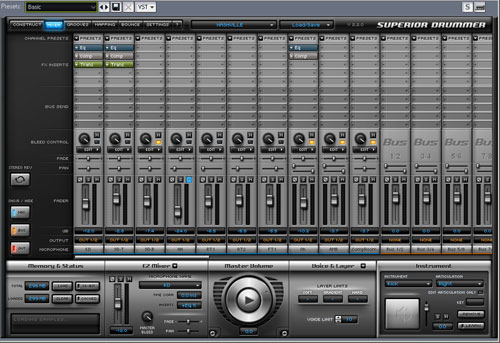 The interface for Superior Drummer is much more complicated, and each channel allows for a multitude of built-in effects.Summary: Toontrack’s VSTi drums offer a few things not available with other sample packs. First, you can get as complicated or simple as you want by using either Superior Drummer or EZDrummer. Secondly, they have expansion packs dedicated to specific genres of music, so if you’re just into jazz you don’t have to blow a lot of cash on other kits that you’ll never use. And finally, they offer some of the most natural and responsive samples out there. The only downsides are that for heavier rock mixes you’re going to have to do a lot of work to get the sounds to punch through the mix (just like you would if mixing a real drum kit), and if you want to own the whole collection you’re going to have to shell out quite a bit of cash.
The interface for Superior Drummer is much more complicated, and each channel allows for a multitude of built-in effects.Summary: Toontrack’s VSTi drums offer a few things not available with other sample packs. First, you can get as complicated or simple as you want by using either Superior Drummer or EZDrummer. Secondly, they have expansion packs dedicated to specific genres of music, so if you’re just into jazz you don’t have to blow a lot of cash on other kits that you’ll never use. And finally, they offer some of the most natural and responsive samples out there. The only downsides are that for heavier rock mixes you’re going to have to do a lot of work to get the sounds to punch through the mix (just like you would if mixing a real drum kit), and if you want to own the whole collection you’re going to have to shell out quite a bit of cash.
***
Electronic Drums in the Studio is written by Ryan Graham, producer for The Dirty Marmaduke Flute Squad. If you like this post check out:
ELECTRONIC DRUMS IN THE STUDIO: Good Enough For Phil Collins, So Suck Our Su-Su-Sudio!: A quick discussion on why we avoid the (figurative and literal) headache of messing with live drums in the studio.

